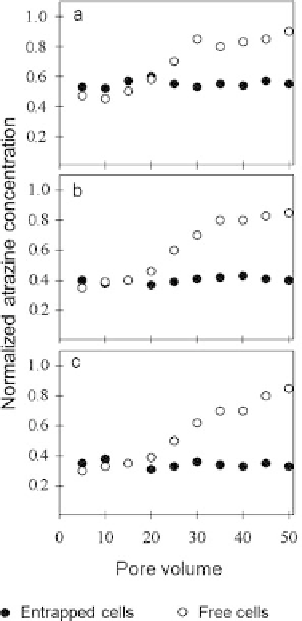Environmental Engineering Reference
In-Depth Information
Fig. 7.13
Long-term column
experimental results of cell
bioaugmentation for treating
atrazine in infiltrate using
PPVA entrapped and free
cells at cell loadings of (
a
)
300, (
b
) 600, and (
c
) 900 mg
dry cells/L empty bed volume
[7], Reprinted by permission
of the publisher
radiobacter
J14a (J14a), a known atrazine degrader, entrapped in PPVA was applied
on a top sand layer and its ability to treat atrazine in a synthetic infiltrate was
compared to bioaugmented free J14a cells. For a short term experiment (6 pore
volumes), the atrazine removal efficiencies of up to 99% were achieved for both the
free and entrapped cells. However, for a long-term experiment (50 pore volumes),
the entrapped cell system provided consistent atrazine removal efficiency while
the atrazine removal by the free cells declined gradually because of the cell loss
(Fig. 7.13).
7.3.2.3 Carragenan and Cellulose Triacetate Entrapped Cell Bioaugmentation
Two investigations on the use of
-CN entrapped cell bioaugmentation for site
remediation have been conducted [76, 77]. Pentachlorophenol was the contaminant
in both studies which focused on different environmental media, soil and water.
Entrapped cells removed PCP from synthetic wastewater 3-times higher than free
cells [76]. For the soil study, PCP removal using free cells, entrapped cells, CN
matrices without cells, and sterile soil (no cells) was compared [77]. The results
indicated that the bioaugmented entrapped cells performed more efficiently reduc-
ing PCP concentration about 64% while PCP removal in the systems with free cells,
κ

